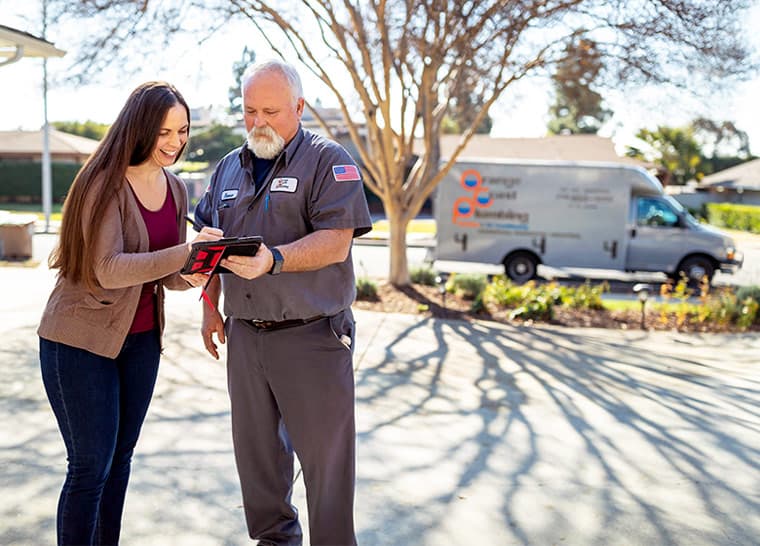It sounds as though a jackhammer has entered your home. It shakes the walls and rattles the pipes.
Welcome to the wonderful world of water hammer, a startling bang in your pipes when you turn a faucet on or off.
It’s annoying and unpleasant, but is it dangerous?
The short answer is, “Yes, it can be.” Left unchecked, it can damage your plumbing.
What Is Water Hammer?
Water hammer, or hydraulic shock, occurs when water suddenly stops or changes direction within a pipe. This abrupt halt or shift creates a pressure wave that travels through the plumbing system, making pipes bang against walls, floors, or each other.
Why Does It Happen?
- Valves that close quickly, like those in washing machines or dishwashers, can suddenly stop water flow.
- High water pressure increases the likelihood of water hammer.
- Loose pipes can move and produce noises when a pressure wave hits.
- Waterlogged air chambers in your plumbing system can lose their ability to absorb pressure changes.
Signs of Water Hammer
The most obvious symptom is a loud bang or series of bangs when you turn off a faucet or valve. You might feel vibrations in the walls or floors near your plumbing.
Persistent water hammer can lead to leaks at pipe joints or fittings. In severe cases, pipes can burst or crack under the repeated stress.
The Risks of Ignoring Water Hammer
Water hammer rarely goes away on its own; it’s a serious plumbing problem you should address.
- Pipes can sustain damage from repeated impact, resulting in leaks or burst pipes.
- Fixtures like faucets and valves can also be affected by water hammer stress, leading to wear and tear or even failure over time.
- Water hammer puts unnecessary strain on your entire plumbing system, which could result in costly repairs down the road.
- If left unchecked, water hammer can also decrease water pressure and flow throughout your home.
DIY Quick Fixes
Before calling in a professional, try these DIY repairs:
1. Check for Loose Pipes & Connections
If you can access your pipes, secure them with clamps or straps and tighten any loose connections. This will prevent movement and reduce the likelihood of water hammer.
2. Drain Air Chambers
Air chambers are vertical pipes installed near water valves that serve as shock absorbers for the pressure surges that cause water hammer. Over time, they can become waterlogged and lose their effectiveness.
To fix this, turn off the main water supply and drain the entire system. This will let air re-enter the chambers and restore their ability to cushion water hammer shocks.
3. Adjust Flow Rate
Gradually opening and closing faucets and valves can manage the water flow, reducing the pressure changes that cause water hammer. Avoiding an abrupt stop can mitigate banging sounds.
4. Check & Replace Worn Out Components
Inspect your faucets and valves for wear and tear. Worn-out washers and seals can contribute to water hammer; replacing them may solve the issue.
5. Insulate Pipes
Adding pipe insulation can dampen the noise created by water hammer. It also protects pipes from temperature variations, which can worsen the condition.
Professional Fixes for Water Hammer
If quick fixes don’t solve the problem, it may be time to call the pros to perform one or more of the following repairs:
1. Lower Water Pressure
A water pressure regulator can stabilize the pressure entering your plumbing system. This prevents sudden pressure surges that lead to water hammer and provides a long-term solution for pressure-related issues.
2. Install Water Hammer Arrestors
Water hammer arrestors are devices installed at key points in your plumbing system to absorb shock waves and prevent them from reaching sensitive fixtures or pipes. A professional plumber can identify the best locations for these devices and install them correctly.
3. Add or Enlarge Air Chambers
Adding or enlarging air chambers in your plumbing can help absorb shock waves. Make sure they’re installed at critical points, like near faucets and appliances.
4. Upgrade Your Plumbing
Older plumbing systems might not have the necessary components to deal with water hammer. Consider upgrading to modern pipes and fixtures designed to handle pressure changes.
5. Reconfigure Pipe Layout
The layout of your plumbing system may be contributing to water hammer. A professional plumber can assess the configuration and re-route pipes if necessary to minimize pressure surges. This may involve adding loops or bends to the piping system, which helps absorb shock waves.
6. Inspect & Repair Water Supply Lines
Cracked or corroded supply lines can exacerbate water hammer issues and risk leaks or flooding. Repairing or replacing damaged lines helps your plumbing system handle pressure changes.
7. Upgrade to Modern Fixtures
Upgrading to high-quality, modern fixtures can reduce the chances of water hammer and improve the overall function of your plumbing system. This may include installing fixtures with built-in anti-hammer features.
FAQs: More about Water Hammer
Q: What causes water hammer in my home?
Water hammer is caused by the sudden stoppage or change in direction of water flow within the pipes. Fast-closing valves, high water pressure, loose pipes, and ineffective air chambers are common culprits.
Q: Is water hammer dangerous?
While not typically dangerous, water hammer can damage plumbing over time. If ignored, it can weaken pipe joints, cause leaks, and even burst pipes.
Q: How can I prevent water hammer?
Maintain your plumbing system, secure loose pipes, install water hammer arrestors, and ensure proper water pressure.
Q: Can I fix water hammer myself?
Some fixes, like securing loose pipes or draining air chambers, are simple enough for DIY enthusiasts. More complex issues may require professional help.
Q: How much does it cost to fix water hammer?
The cost varies depending on the severity of the problem and the solution required. Simple fixes might cost little to nothing, while extensive plumbing upgrades can be expensive.
Q: Does water hammer occur in all types of plumbing systems?
Water hammer can occur in residential and commercial plumbing systems, whether they use copper, PVC, or galvanized steel pipes. It is a result of hydraulic shock, which can affect any system.
Q: Can water hammer damage my appliances?
Yes, especially those connected to your plumbing system, like dishwashers and washing machines. Repeated pressure surges can wear out components.
Q: How often should I inspect my plumbing system for signs of water hammer?
Inspect your plumbing system at least once a year. Look for loose pipes, worn-out components, and signs of leaks. Early detection can help you address water hammer issues before they become severe.
Q: Are there specific times when water hammer is more likely to happen?
Water hammer is more likely to occur during sudden changes in water flow, such as when faucets are turned off abruptly or when appliances like washing machines or dishwashers complete their cycles. It can also be more prevalent during high water use.
Q: Can adding extra supports and brackets help with water hammer?
Yes. Properly secured pipes are less likely to move and cause the pressure surges that lead to water hammer. This is a relatively simple and cost-effective DIY solution.


